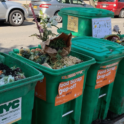

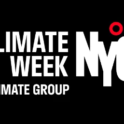
Climate Week NYC is a week of events run by The Climate Group that has taken place every year in New York City since 2009. The summit takes place alongside the UN General Assembly and brings together international leaders from business, government and civil society to showcase global climate action. This year Climate Week runs from September 19th-25th.
There are numerous events open to the public throughout the week which you can find ?on the Climate Week website. We encourage you to register for and attend these events to learn more about how major companies, businesses, and government officials plan to address the climate crisis. If you are not located in NYC, some events may be available to attend virtually.
If you are unable to attend any of the events, you can still celebrate Climate Week by making an effort to create sustainable habits in your everyday life. Checkout some suggestions below!
- Turn it off: Saving energy is one of the most important things you can do to reduce your carbon footprint. Leaving electricity on when it’s not being used consumes unnecessary energy. Press the off switch and you will see significant improvements- most noticeable on your electric bill!
- Eat less meat: Careful eating is at the heart of a greener approach, and cutting back on meat consumption can make a big difference. Cutting out red meat, even two or three days a week, can have a huge impact on reducing your carbon footprint. According to The Science Report, if everyone in the country reduced their consumption of red meat by a quarter and replaced it with plant protein, we’d save about 82 million metric tons of greenhouse gas emissions per year.
- Stop wasting Food: The United States discards more food than any other country in the world. Nearly 30-40 percent of the entire US food supply is wasted each year. This equates to 219 pounds of waste per person. Americans often discard perfectly good food because they misunderstand expiration labels. Food waste can be reduced by mindful consumption, improving storage spaces, and educating yourself on true lifespans of different foods.
- Reduce-Reuse-Recycle: You’ve heard this term a million times, but it is a very effective mantra to live by if you’re trying to live a more sustainable lifestyle. The first step is reducing the amount of products you buy in general, leading to lower emissions related to production, transportation, and eventually waste. Reusing your products for as long as you can will also prolong their lifespan, thus also lowering emissions related to producing and purchasing a new product. Finally, if you are able to, please recycle your waste. Recycling programs are specific to the area you live in, so check out your town’s recycling programs and policies to get started.
- Cut down on Plastic: Plastic seems to have made its way into every aspect of our lives. But giving it up isn't as hard as you might think -- take a reusable bag with you when you go grocery shopping, buy products in bulk when you can, and start using a reusable water bottle. According to this article, more than 60 million plastic water bottles are thrown away everyday in the US.
We hope you have a safe and happy Climate Week! Check back next week for more green tips.
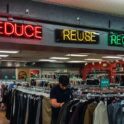
Fast fashion is an environmental problem on a myriad of different levels. The US throws out 11.3 million tons of clothing per year, or 2,150 pieces of clothing per second, 10% of global carbon emissions are caused by the fashion industry, and it takes 1,800 gallons of water to make a single pair of jeans. The good news is that second-hand clothing is a sustainable, and an increasingly popular option. Buying second-hand clothing avoids the carbon emissions and water waste used to make new clothing, and it prolongs the life-span of clothing by keeping it out of a landfill. Although buying second-hand clothing is great for the environment, it can often be difficult to know where to start. There are many ways to shop second-hand, and the best option for you will be different depending on your budget, personal style, and the amount of time you have available for shopping. This guide should help you get started on your thrifting journey!
Shopping in Person:
The main differences between physical stores depend on their size, price and level of curation. Out of physical stores, thrift stores are the most cost-effective, as they are mostly donations-based. Thrift stores are often the largest and include big stores like Goodwill and Salvation Army. Vintage stores are the next step up from thrift stores. These stores are more curated, sometimes focusing on a specific style or era of clothing, but that means that prices are higher. Vintage stores are a great option if you are particular about what you want to wear, and want to avoid spending time searching for it. Finally, the most expensive type of second-hand store is a consignment store. Consignment stores focus on luxury items, and they have much higher prices. Consignment stores are often a more affordable option than buying designer clothing new, but they are still very pricey.
To find second-hand stores near you, a Google Maps search is the best way to start. You can also look on local bulletins to find information about temporary sales, like garage sales, rummage sales and flea markets.
When you first go to a second-hand shop, you might be overwhelmed by the amount of options. A good place to start can be by deciding if you are looking for something in particular- like long skirts, or fun graphic t-shirts. Before going shopping, look through your closet and make note of your favorite pieces, and what you wear the most. When deciding on a clothing item, you can think about how well it would go with what you already own, and how much you would realistically wear it. A good rule of thumb is to try to come up with 5 ways you could wear a piece of clothing with the clothes you already own.
Finally, the best tip for shopping in-person is to have fun with it, no matter the outcome. Shopping second-hand can be unpredictable, and the selection of clothing can vary dramatically. If you use shopping as a way to hang out with a friend, or have fun browsing sections like books or cutlery, you’ll be less likely to be disappointed if you can’t find any clothing you like.
Shopping Online:
Recently online second-hand shops have exploded in popularity, and they are an excellent way to buy clothing in an easy, time-efficient way. Like physical stores, there are many different websites and apps for second-hand shopping, and they each have their own strengths and weaknesses.
One of the best places to start for people who are new to thrifting is the website ThredUp. ThredUp sells clothing at a vast array of price ranges, based on the condition and original price of a piece of clothing. They sell clothing from over 35,000 brands, at discounts of up to 90% off of the retail value. This website is particularly good for beginners because unlike other websites where individual sellers upload photos and descriptions of clothing, ThredUp photographs and measures the clothing themselves. They also include verified information about the condition, fabric and original price of clothing. The website also lets you search by brand of clothing, and size, making it easier to find clothing that you know you will like. ThredUp also stands out from many other second-hand stores because it allows you to make returns on clothing. Finally, if you are eyeing a piece of clothing on ThredUp, hang on to see if a sale is coming up. The website frequently has sales of up to 60-70% off!
Another popular way to buy second-hand clothing is the website and app Poshmark. Poshmark is different from ThredUp because all of the clothing is sold by individual people and boutiques, and not by the company itself. Poshmark also makes it easy to search by size and brand of clothing, but prices are set by the sellers, so they are not as consistent as on ThredUp. This can be good, because you can find great-priced vintage clothing from people clearing out their closets, and you have the option to negotiate on prices, but it also opens up the possibility of getting scammed. If a seller lies about the condition of an item of clothing you will be able to get your money back, but you are not protected against overpaying for clothing. Make sure that you look at the reviews of a seller before buying anything, and check the prices of the new clothing from a brand when deciding if the second-hand price is fair.
Another website and app that is very popular right now is Depop. Depop is structured to resemble a social media feed, and therefore tends to be more creative than ThredUp and Poshmark. People sell their homemade and upcycled clothing as well as thrifted items on Depop, and sellers usually go out and source clothing to sell, instead of selling what they already own. This means that very unique items are often available on Depop, but also that prices run higher. Like Poshmark, you should be wary of scams while shopping. Depop is a great option for people who are comfortable using social media, but the format may challenge those who are unfamiliar with it.
Finally, online consignment stores like The RealReal and Vestiaire Collection are great options for vintage designer clothing. Both websites are very safe, and they authenticate their items, but they run on the pricier side.
Shopping second-hand can seem daunting at first, but it gets easier when you get used to it, and have a chance to come up with your own tips and strategies. This guide should give you a good start, but the most important thing you can do is experiment and find out what fits into your life best. Doing this will make your second-hand shopping experience both sustainable and fun!
By Julia Krushelnycky
On August 16th, New York Governor Kathy Hochul directed the New York State Department of Environmental Conservation to expand the state’s drought watch to 49 counties- every county except for those in the Great Lakes, Adirondack and NYC / Westchester regions. This announcement follows the July 29th addition of 21 counties in Western and Central New York to the state’s drought watch. The current drought risk comes from the combination of above average temperatures and low rainfall throughout the state. New York’s “Watch” category is the lowest risk out of the four drought categories of: Watch, Warning, Emergency and Disaster. Under the drought watch no mandatory water use restrictions are in place, but residents are strongly encouraged to reduce their personal water use. Here are some ways that you can cut down on your water consumption:
- Watering Lawns: The most effective way to conserve water with your lawn is to water it less often. Turning off sprinkler systems, and reducing how often you water your lawn will both drastically cut down on your water usage. Some other ways to cut back on water use are watering your lawn early in the morning, which can reduce evaporation, and cutting grass at a higher height, which leads to healthier grass that uses less water. You can also collect rainwater, and use it to water your plants. Finally, consider petitioning your local golf course to upgrade to a more efficient sprinkler system, or cut back on how often they water their greens. A 2015 study found that on average US golf courses use 130,000 gallons of water each day per course, numbers that are unsustainable given the current drought conditions.
- Showers: A great way to cut down on home water usage is to conserve water in the shower. This can include turning off your shower when you shampoo your hair, buying a water conserving shower nozzle, or taking less time in the shower overall.
- Washing Sustainably: Using running water to wash things such as dishes, produce, cars and sidewalks can use a lot more water than is necessary. Instead of keeping water running indefinitely, using a sponge, or letting something soak in a basin is an easy way to reduce water waste. Next time, try washing your fruit in a bowl instead of under the tap, washing a car with a sponge and bucket instead of going to a car wash, or sweeping the sidewalk instead of hosing it off. For appliances like dishwashers and washing machines, make sure you only use them when they are full.
- Pipe Maintenance: If you have any leaky pipes, faucets or hoses, make sure you get them fixed! Even small leaks can add up to waste a lot of water over time, and this is the perfect time to work on them.
- Groundwater Well Regions: The drought watch in New York will most affect the regions that rely heavily on groundwater wells, meaning that New Yorkers in those regions should work especially hard to conserve water. This website has information on the levels of groundwater wells by county, and it can help you find out where your county stands in terms of its groundwater wells.
- Wildfire Prevention: In addition to the drought watch, the majority of New York State is also under high wildfire risk. Drought conditions feed into the wildfire risk, so it is especially important right now to take steps against wildfires. When camping, use existing fire pits, clear fire areas of flammable materials, and do not leave campfires unattended under any circumstances. It is also crucial to drown out fires with water after use, including any embers that may be covered.
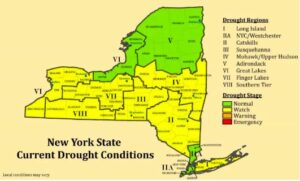
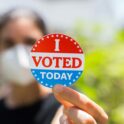
Happy primary season, New York! Here we have a guide for how to vote in the upcoming primary elections on August 23rd.
The primary elections for the House of Representatives and New York State Senate are scheduled for August 23 this year. Primary elections are used to select a candidate for each political party, so you need to be registered for a party in order to vote in a New York primary election. You can register for a party when you register to vote in New York, or whenever you change your voter registration information. The four recognized parties in New York are the Democratic, Republican, Conservative and Working Families parties. For this year, the deadline to register for a party or change parties is August 11, but you can still vote in the general election on November 8th if you are not registered for a party. The deadline to register to vote in the general election is October 14th, and you can find information on how to register to vote here. The list of candidates running in these primary elections can be found here.
If the primaries feel later this year, that’s because they are! New York State Senate and Congressional primaries are later than usual because of statewide redistricting that happened this year. You can find out more about the reason for the late primary dates here. To find out if you have been redistricted this year, you can use this website to look at the State Senate and Congressional district maps before and after redistricting, or search by your address to find your current district.
Vote early for this primary election between August 13th-August 21st! If you vote early you can skip long lines on election day, and can get voting out of the way! Detailed information on how to vote early is listed here, on the website Vote Early NY.
Absentee ballots are another option for people who will be out of their county on election day, or who are worried about the transmission of infectious diseases such as Covid-19. For those who are planning to vote via absentee ballot, the deadline to request an absentee ballot by mail has passed, but you can still request an absentee ballot in person at your local Board of Elections until August 22nd. In order for ballots to be valid they need to be dropped off at your local Board of Elections or your polling site by August 23rd at latest, or postmarked by August 23rd and received by August 30th if mailed in. If you plan on requesting an absentee ballot, please note that voters who have requested an absentee ballot will no longer be able to vote with a polling machine on Election Day, but they will still be able to vote in person using an Affidavit ballot at their polling place. More information on how to vote via absentee ballot is available here, on the New York Board of Elections website.
If you plan to vote in person on election day, check to see if your polling place has changed using this website, and set a reminder for yourself to vote on the 23rd!
Use this link to find a list of candidates endorsed by the New York League of Conservation Voters, and happy voting!

Social media is a great way to express your creativity, and get inspired by others. By following sustainability focused pages on social media you can gain motivation to make sustainable lifestyle changes, and build community around sustainability. Eco-friendly social media pages come in all different shapes and sizes, making it easy to find something that you will be interested in. Here are a few of our favorite Instagram pages!
- @Zerowastechef - Anne-Marie Bonneau is the author of The Zero Waste Chef: Plant-Forward Recipes and Tips for a Sustainable Kitchen and Planet. On her Instagram page she shares her tips on topics like sustainable recipes, composting, fermentation for beginners and sustainable food shopping.
- @Queerbrownvegan - Isaias Hernandez uses their Instagram page to talk about the social impacts related to the sustainability movement. Their page includes helpful videos about environmental issues such as climate justice and the relationship between climate change and diseases.
- @Easyecotips - This page shares a mix of infographics with sustainable tips, such as flowers to plant to support bees, or apps that can help you with sustainability, as well as news on the environment.
- @Aditimayer - Aditi Mayer is a fashion influencer and labor rights activist who advocates for sustainable and ethical fashion practices. Her Instagram page showcases new and interesting sustainable fashion brands and provides information on how to consume fashion responsibly.
- @Remakeourworld - Remake Our World is a sustainable fashion page that advocates for lifestyle changes around fashion, including breaking cycles of consumerism and embracing handmade and thrifted fashion. The page explains environmental and ethical issues with fast fashion and gives ideas for how to shop more sustainably.
- @Melissa.hemsley - Melissa Hemsley is the author of four cookbooks including 2020’s Eat Green. On her instagram page melissa.hemsley the author shares recipes, tutorials and tips on how to make delicious sustainable food.
- @Intersectionalenvironmentalist - Intersectional Environmentalist is a non-profit founded by Leah Thomas, the author of the 2022 book The Intersectional Environmentalist: How to Dismantle Systems of Oppression to Protect People + Planet. The organization’s Instagram page speaks about the disproportionate effects of environmental issues on marginalized communities, as well as sharing environmental news and tips.
- @Waterthruskin - Valerie Hinojosa is a sustainability influencer who shares sustainable home and lifestyle tips in English and Spanish on her Instagram page. Check out her page for ideas on sustainable beauty, home decor and cooking.
- @NYLCV - Finally, NYLCV! Follow us on Instagram to keep up with all of our work and actions you can take to support us!
We hope that these social media pages will get you excited about living more sustainably!
Thank you to all of the candidates and campaign staff who joined the New York League of Conservation Voters Education Fund over the past few weeks for our 2021 NYC Environmental Candidate Schools. These discussions were designed to educate and inform campaigns for City Council, Borough President, Comptrollers, and Mayor on key environmental and public health issues facing our city. Below you will find links to recordings, contact information for our panelists, and the presentations from each panel.
Waste Management and Building Emissions
Panelists
- Bridget Anderson, Deputy Commissioner of Recycling and Sustainability, NYC Department of Sanitation
- Eric Goldstein, Senior Attorney and NYC Environment Director, Natural Resources Defence Council
- Phoebe Flaherty, Organizer, ALIGN: the Alliance for a Greater New York
- Adam Roberts, Director of Policy, NY American Institute of Architects
- Chris Halfnight, Associate Director of Policy, Urban Green Council
- Donna DeCostanzo, Eastern Region Climate and Clean Energy Program Director, Natural Resources Defence Council
- Marlene De La O, Strategic Research and Policy Analyst, ALIGN: the Alliance for a Greater New York
Infrastructure: Transportation + Wastewater and Green Infrastructure
Panelists
- Danny Pearlstein, Policy and Communications Director, Riders Alliance
- Kate Slevin, Senior VP State Programs and Advocacy, Regional Plan Association
- Jenny Veloz, Community Organizer, New York Lawyers for the Public Interest
- Julie Welch, Program Manager, Stormwater Infrastructure Matters (SWIM) Coalition
- Emily Maxwell, NYC Program Director, The Nature Conservancy
- Lisa Bloodgood, Director of Advocacy and Education, Newtown Creek Alliance
Public Health & Parks: Lead Poisoning + Parks and Open Spaces
Panelists
- Dr. Morri Markowitz, Director, The Children's Hospital at Montefiore
- Taylor Morton, Director of Environmental and Health Education, WE ACT for Environmental Justice
- Brandon Kielbasa, Director of Organizing and Policy, Cooper Square Committee
- Liam Reilly, Tenant Organizer, Cooper Square Committee
- Emily Walker, Director of Outreach and Programs, New Yorkers for Parks
- Carter Strickland, New York State Director, The Trust for Public Land
- Sarah Charlop-Powers, Executive Director, Natural Areas Conservancy
- Masoom Moitra, Green Light District Director, El Puente
Resiliency: Heat Vulnerability and Coastal Resiliency
Panelists
- Daphne Lundi, Independent Expert on NYC Resiliency
- Sonal Jessel, Director of Policy, WE ACT for Environmental Justice
- Sam Bishop, Director of Education, Trees New York
- Karen Imas, Vice President of Programs, Waterfront Alliance
- Amy Chester, Managing Director, Rebuild By Design
- Judah Asimov, Senior Manager of Planning and Outreach, RISE Rockaways
Additional Resources
From the Citizen’s Toolkit
Temperatures are finally starting to drop, and we’re welcoming the crisp autumn air. One of the best ways to fully appreciate and experience the beauty of it is to spend time in one of New York State’s parks. Boasting some of the most beautiful nature in America, New York is home to over 200 state…
With travel, gift giving, and many big meals, the winter holidays are one of the times of the year with the highest rates of personal consumption. Because of this heightened consumption rate, the holidays are the time when being conscious of sustainable practices will have the greatest total impact. Here are some holiday practices you can take to generate an impact, and others that can help foster a sense of love and consciousness toward the environment.
Are you planning on starting 2018 off with the ever-popular goal of working out more often? If so, we have some tips to help you burn calories while staying environmentally friendly. Working out offers countless benefits to the mind and body, but if you’re not careful, it can cause a detriment to your ecological footprint….
On Tuesday, November 8th, voters on the East End of Long Island had an important environmental decision to make on their ballots: whether or not to extend the Community Preservation Fund (CPF) in the five East End towns.
Each year, NYLCV and the NYLCV Education Fund work closely with New York’s leading environmental, public health, conservation, energy, environmental justice, and transportation organizations to identify the state’s most pressing priorities on fighting climate change, conserving land and water, and protecting public health. The result of that effort is our 2017 New York State legislative…
Water issues might not be making as many headlines anymore, but even if your local supply hasn’t made it to the news, you might remain at risk without knowing it. Given the number of contaminants that can make their way into shared or even private wells, you’ll need to make sure your drinking water stays…
The summer heat means more sweat, and by extension more loads of laundry to do. However there a variety of practices other than re-wearing your sweaty gym clothes that can make your laundry practices more sustainable. Wash with Cold Water Studies show that 75% of the total energy-use and carbon emissions associated with your laundry…
Eating locally is easy in the summer, when farm stands seem to be overflowing with fresh fruits, veggies, and leafy greens, so now is the best time to build a seasonal eating habit. Here are some more tips to help you green your diet:
The New York League of Conservation Voters Education Fund is pleased to present this 2017 Green Guide as a resource for all candidates running for public office in New York City. This document, released at our Environmental Candidate School, is a one-stop-shop for candidates to learn about new opportunities and approaches to persistent sustainability problems….
Temperatures are finally starting to drop, and we’re welcoming the crisp autumn air. One of the best ways to fully appreciate and experience the beauty of it is to spend time in one of New York State’s parks. Boasting some of the most beautiful nature in America, New York is home to over 200 state…
With travel, gift giving, and many big meals, the winter holidays are one of the times of the year with the highest rates of personal consumption. Because of this heightened consumption rate, the holidays are the time when being conscious of sustainable practices will have the greatest total impact. Here are some holiday practices you can take to generate an impact, and others that can help foster a sense of love and consciousness toward the environment.
Are you planning on starting 2018 off with the ever-popular goal of working out more often? If so, we have some tips to help you burn calories while staying environmentally friendly. Working out offers countless benefits to the mind and body, but if you’re not careful, it can cause a detriment to your ecological footprint….
On Tuesday, November 8th, voters on the East End of Long Island had an important environmental decision to make on their ballots: whether or not to extend the Community Preservation Fund (CPF) in the five East End towns.
Each year, NYLCV and the NYLCV Education Fund work closely with New York’s leading environmental, public health, conservation, energy, environmental justice, and transportation organizations to identify the state’s most pressing priorities on fighting climate change, conserving land and water, and protecting public health. The result of that effort is our 2017 New York State legislative…
Water issues might not be making as many headlines anymore, but even if your local supply hasn’t made it to the news, you might remain at risk without knowing it. Given the number of contaminants that can make their way into shared or even private wells, you’ll need to make sure your drinking water stays…









